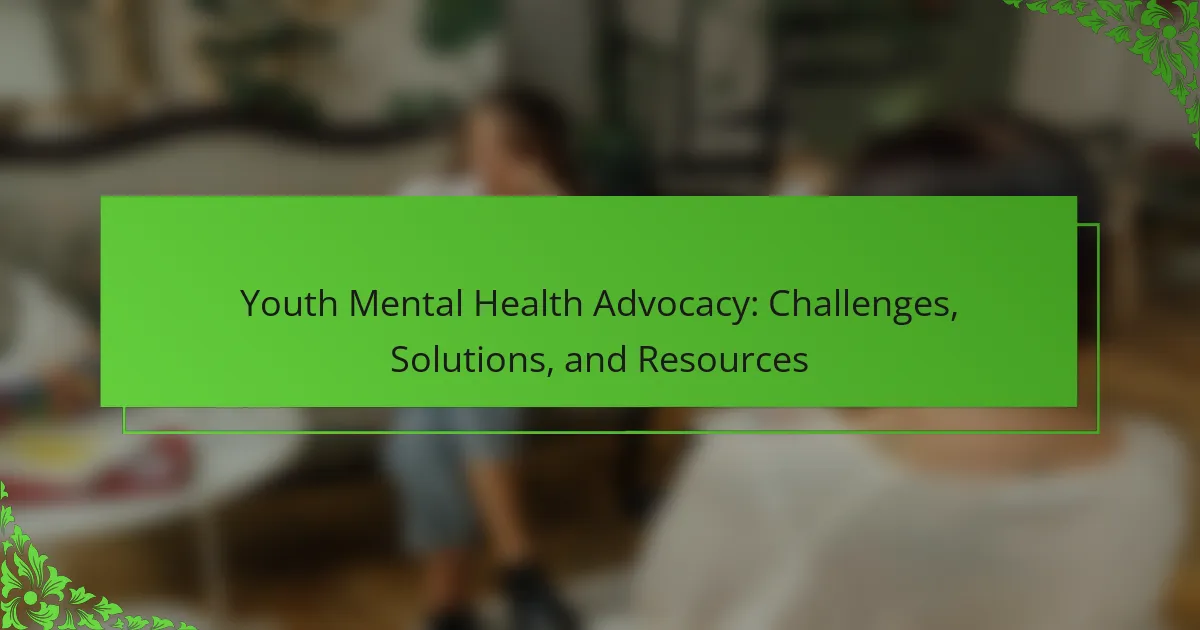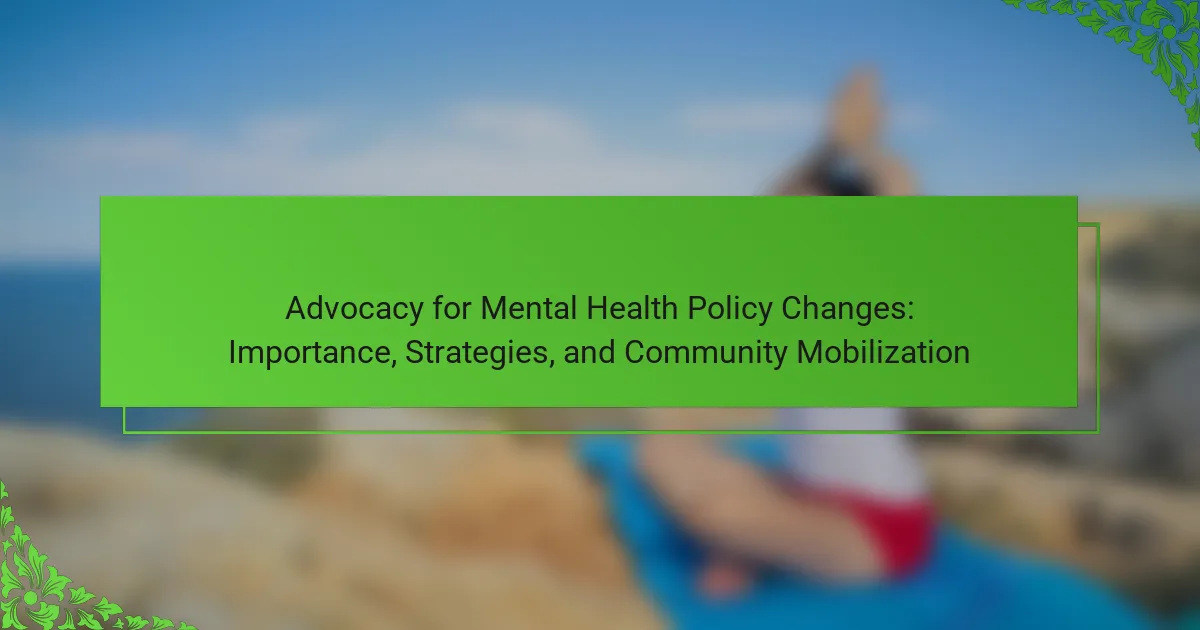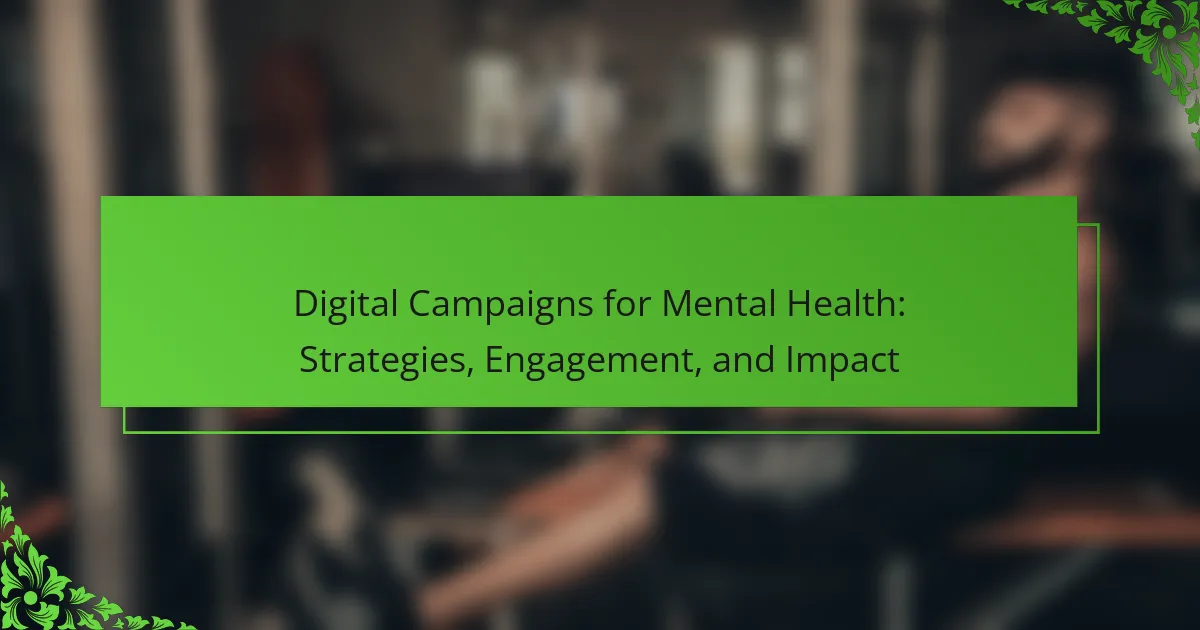Youth mental health advocacy faces significant challenges, including stigma, limited resources, and funding constraints. Solutions like school-based programs and digital resources are being implemented to improve access. Numerous organizations provide essential support and tools for advocacy. Cultural perceptions also play a crucial role in shaping attitudes towards youth mental health issues.
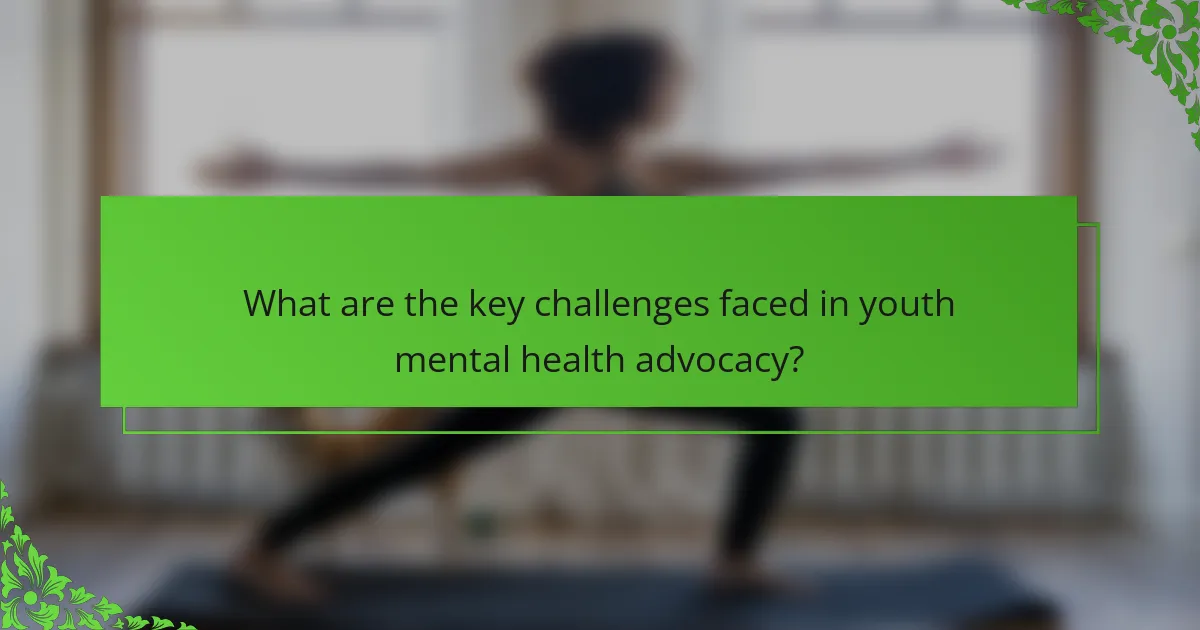
What are the key challenges faced in youth mental health advocacy?
Youth mental health advocacy faces several key challenges. Stigma surrounding mental health persists, making it difficult for youth to seek help. Limited access to resources, including mental health professionals, exacerbates the issue. Additionally, funding constraints hinder the development of effective programs. Advocacy efforts often lack awareness and visibility, reducing impact. Finally, the diversity of youth experiences complicates the creation of universally applicable solutions. Addressing these challenges requires collaborative efforts, increased funding, and targeted awareness campaigns.
How do stigma and discrimination impact youth mental health?
Stigma and discrimination significantly harm youth mental health by creating barriers to seeking help. These negative perceptions lead to feelings of isolation and low self-esteem, exacerbating mental health issues. Research shows that youth facing stigma are less likely to access mental health services, increasing the risk of depression and anxiety. Additionally, the internalization of stigma can result in a negative self-image, further complicating recovery and overall well-being. Addressing stigma through advocacy and education is crucial for improving mental health outcomes for young people.
What barriers do advocates encounter in policy-making processes?
Advocates face several barriers in policy-making processes, including lack of funding, political resistance, and insufficient data. These challenges hinder effective communication and limit the impact of youth mental health initiatives. Additionally, advocates often encounter bureaucratic obstacles that slow down the implementation of policies. Collaboration with stakeholders is essential to overcome these barriers and promote informed decision-making.
How does access to mental health resources vary by region?
Access to mental health resources varies significantly by region due to factors like funding, cultural attitudes, and availability of services. Urban areas often have more resources compared to rural regions, which may face challenges like stigma and limited access to professionals. For instance, regions with higher funding for mental health initiatives typically report better youth engagement and support systems. Conversely, areas with lower investment struggle to provide adequate resources, leading to disparities in youth mental health outcomes.
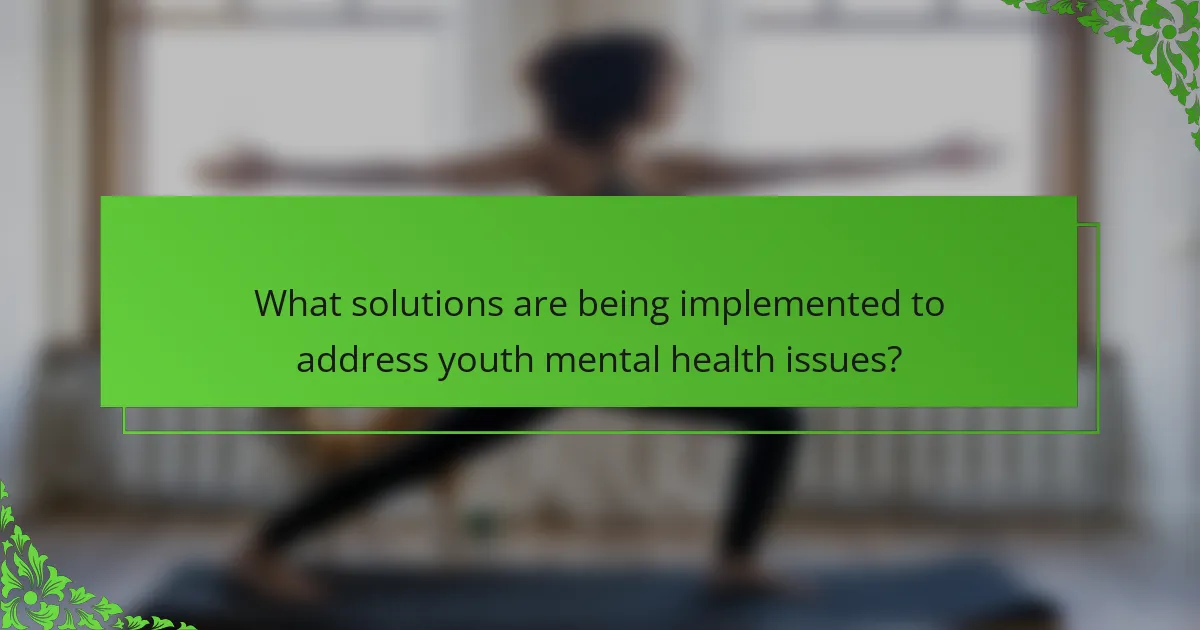
What solutions are being implemented to address youth mental health issues?
Various solutions are being implemented to tackle youth mental health issues. These include school-based mental health programs, community outreach initiatives, and digital mental health resources.
School-based programs provide accessible support directly in educational settings, addressing issues like anxiety and depression. Community outreach initiatives engage youth through workshops and peer support groups, fostering a sense of belonging. Digital resources, including apps and online counseling, offer flexible options for those hesitant to seek traditional help.
Investing in training for educators and parents enhances awareness and support systems. Collaboration among stakeholders, including mental health professionals and policymakers, is vital to create comprehensive strategies. These combined efforts aim to reduce stigma and improve access to mental health care for youth.
Which innovative programs are successfully engaging young people?
Innovative programs successfully engaging young people in mental health advocacy include peer support initiatives, digital mental health platforms, and community-based workshops. These programs focus on reducing stigma and increasing access to resources. For example, youth-led organizations often create safe spaces for open dialogue, fostering a sense of belonging. Additionally, technology-driven solutions like mobile apps provide immediate support and resources, appealing to tech-savvy young audiences.
How can schools play a role in promoting mental wellness?
Schools can significantly promote mental wellness through targeted programs and supportive environments. They can implement mental health education, provide access to counseling services, and foster peer support networks. These initiatives help reduce stigma and encourage open discussions about mental health.
Additionally, schools can train staff to recognize signs of mental distress and respond appropriately. Collaborating with mental health professionals can enhance resources available to students. Engaging parents and the community in mental wellness initiatives creates a holistic support system.
Research indicates that schools with comprehensive mental health programs see improved student well-being and academic performance. By prioritizing mental wellness, schools contribute to healthier future generations.
What community-based approaches have shown effectiveness?
Community-based approaches that effectively support youth mental health include peer-led initiatives, school-based programs, and family engagement strategies. These methods foster supportive environments and enhance access to resources. Peer-led initiatives promote shared experiences, reducing stigma and encouraging open dialogue. School-based programs provide mental health education and services, integrating support within familiar settings. Family engagement strategies involve parents and guardians in the mental health process, ensuring a holistic approach to well-being. Collectively, these strategies address unique challenges faced by youth, promoting resilience and emotional health.

What resources are available for youth mental health advocacy?
Numerous resources support youth mental health advocacy, including organizations, online platforms, and community programs. Notable entities like the National Alliance on Mental Illness (NAMI) provide educational materials and support networks. Mental Health America offers toolkits for advocacy and awareness campaigns. The Substance Abuse and Mental Health Services Administration (SAMHSA) provides funding opportunities and resources for local initiatives. Peer support programs empower youth to engage in advocacy, fostering leadership skills. Additionally, social media platforms serve as a space for awareness and community building.
Which organizations provide support and funding for mental health initiatives?
Organizations that provide support and funding for mental health initiatives include government agencies, non-profits, and foundations. These entities focus on youth mental health advocacy, addressing challenges and offering resources.
Key organizations include:
National Institute of Mental Health | Federal agency focusing on mental health research and funding initiatives.
Substance Abuse and Mental Health Services Administration | Provides grants and resources for mental health programs.
Mental Health America | Non-profit organization advocating for mental health awareness and funding.
National Alliance on Mental Illness | Offers support and education for mental health advocacy.
Robert Wood Johnson Foundation | Funds health-related initiatives, including mental health programs.
The Trevor Project | Focuses on crisis intervention and suicide prevention for LGBTQ+ youth.
These organizations play crucial roles in enhancing youth mental health resources and solutions.
What online platforms are useful for advocacy and awareness?
Social media platforms like Instagram, Twitter, and TikTok are effective for youth mental health advocacy. These platforms enable the sharing of personal stories, educational content, and community support. They also facilitate engagement through hashtags and campaigns, reaching a wider audience. For example, Instagram’s visual appeal can highlight mental health resources, while Twitter allows real-time discussions on mental health topics. TikTok’s short videos foster creativity in spreading awareness and connecting with younger audiences.
How can social media be leveraged for mental health campaigns?
Social media can effectively raise awareness and promote engagement in mental health campaigns. Platforms like Instagram and Twitter allow youth to share personal stories, reducing stigma and fostering community support.
Engaging content, such as infographics and videos, can simplify complex mental health topics. Campaigns that encourage user-generated content can amplify voices and experiences, creating a sense of belonging.
Collaborating with influencers can enhance outreach, as they can connect with diverse audiences. Regular interactions through live sessions or Q&A can further engage youth, providing immediate support and resources.
Analytics tools can measure campaign impact, helping to refine strategies. By leveraging these social media attributes, mental health advocacy can resonate more effectively with young people.
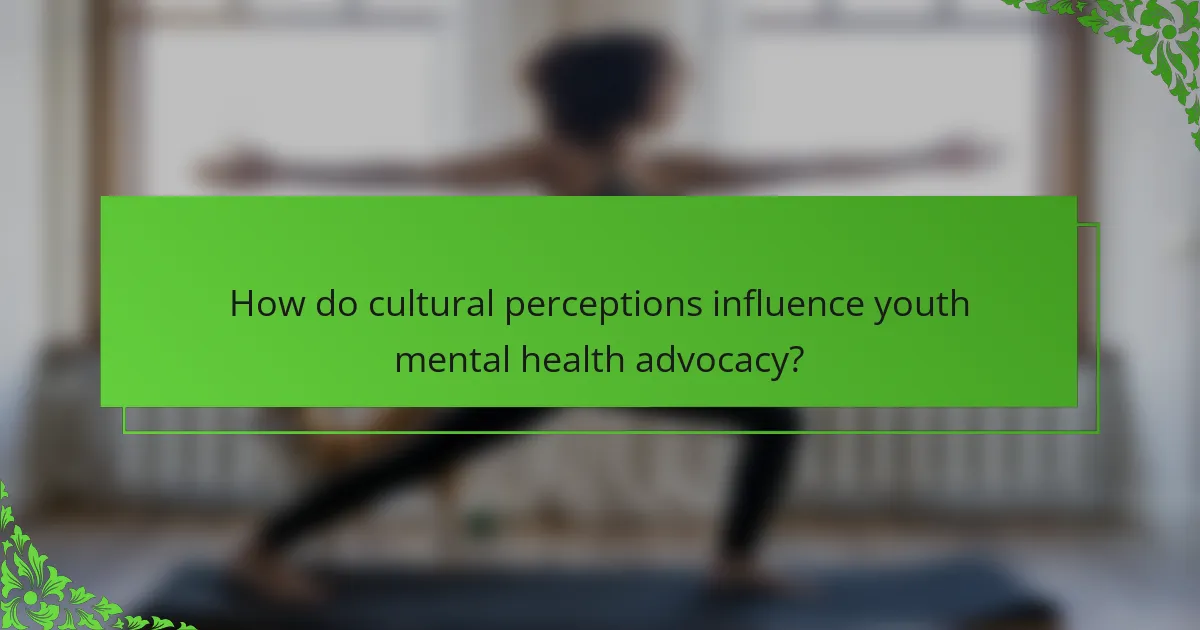
How do cultural perceptions influence youth mental health advocacy?
Cultural perceptions significantly shape youth mental health advocacy by influencing attitudes and approaches to mental health issues. For instance, stigma surrounding mental health can deter young individuals from seeking help. In cultures where mental health is openly discussed, youth are more likely to engage in advocacy and support initiatives. Research shows that positive cultural narratives can foster resilience and encourage proactive mental health strategies among young people. Additionally, community involvement in advocacy efforts enhances awareness and reduces stigma, creating a more supportive environment for youth mental health.
What role do family dynamics play in mental health awareness?
Family dynamics significantly influence mental health awareness among youth. Supportive family environments foster open discussions about mental health, reducing stigma and encouraging help-seeking behaviors. In contrast, dysfunctional family interactions can exacerbate mental health issues, leading to isolation and misunderstanding. Research indicates that youth with strong familial support are more likely to engage in mental health advocacy. Furthermore, family involvement in mental health education enhances awareness and resource accessibility, promoting overall well-being.
How do different cultural backgrounds affect the approach to mental health?
Cultural backgrounds significantly shape approaches to mental health among youth. Different societies possess unique beliefs, practices, and stigmas surrounding mental health, influencing how young people seek help and support.
For instance, collectivist cultures often emphasize family involvement in mental health decisions, while individualistic cultures may prioritize personal autonomy. This distinction affects access to resources, with some cultures favoring traditional healing practices over professional mental health services.
Additionally, language barriers can hinder communication in mental health settings, impacting diagnosis and treatment. Understanding these cultural nuances is essential for effective advocacy and tailored support strategies.
Ultimately, promoting mental health awareness requires culturally sensitive approaches that respect diverse backgrounds and encourage open dialogue.
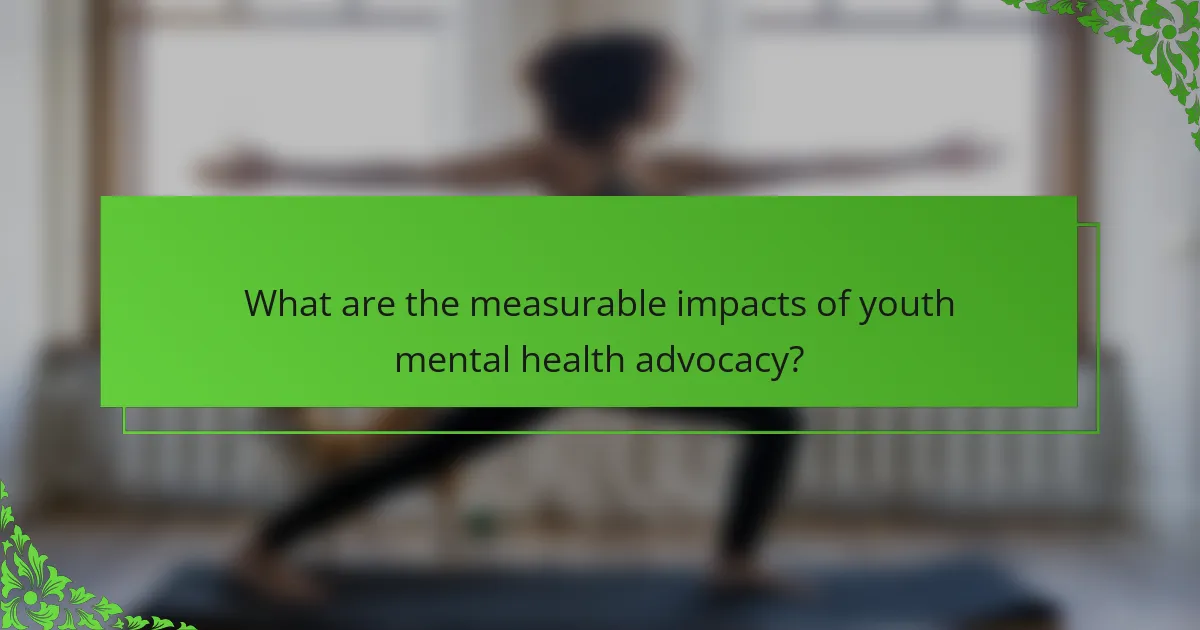
What are the measurable impacts of youth mental health advocacy?
Youth mental health advocacy significantly improves awareness and access to resources for young people. It leads to reduced stigma, increased funding for mental health programs, and enhanced community support. Research shows that advocacy efforts correlate with a 20% increase in youth seeking mental health services. Additionally, advocacy fosters policy changes that prioritize mental health in educational institutions. Engaging youth in advocacy empowers them, promoting resilience and well-being.
How can success be quantified in advocacy efforts?
Success in youth mental health advocacy can be quantified through measurable outcomes such as increased awareness, improved access to resources, and positive changes in mental health policies. Key indicators include the number of campaigns launched, engagement levels on social media, and the implementation of support programs. Tracking these metrics helps assess the effectiveness of advocacy efforts and identify areas for improvement.
What long-term benefits arise from effective youth mental health programs?
Effective youth mental health programs yield long-term benefits such as improved emotional resilience, enhanced academic performance, and reduced rates of anxiety and depression. These programs foster healthy coping strategies and social skills, which are essential for lifelong mental well-being. Long-term engagement in such initiatives correlates with lower healthcare costs and better community outcomes. Additionally, they create supportive environments that encourage open conversations about mental health, reducing stigma and promoting awareness.
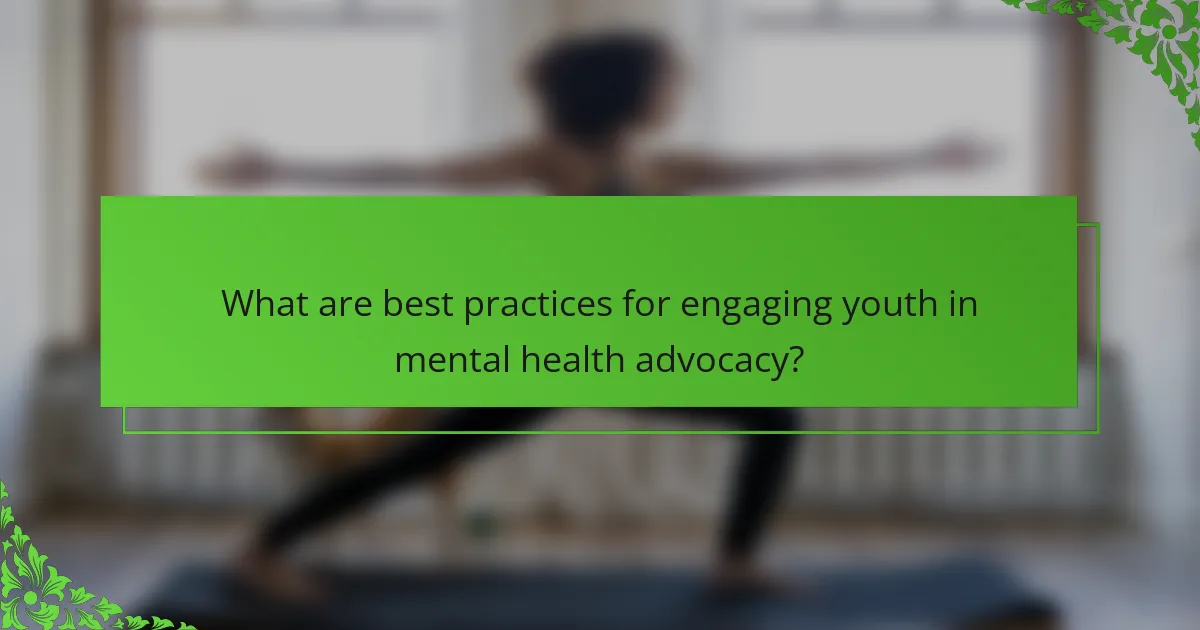
What are best practices for engaging youth in mental health advocacy?
Engaging youth in mental health advocacy requires active participation, education, and support. Encourage open discussions about mental health in safe environments. Utilize social media platforms to raise awareness and share personal stories. Collaborate with schools and community organizations to create programs that empower youth. Provide training on advocacy skills to equip young people with the tools needed for effective engagement. Foster peer support networks to enhance connection and resilience among youth.
How can advocates effectively communicate with young audiences?
Advocates can effectively communicate with young audiences by using relatable language and engaging platforms. They should prioritize authenticity and transparency in their messaging. Utilizing social media and interactive content fosters connection and encourages dialogue. Tailoring communication to address specific mental health challenges faced by youth enhances relevance and impact.
What common mistakes should be avoided in advocacy efforts?
Common mistakes in youth mental health advocacy include lack of clear messaging, underestimating the importance of data, failing to engage youth voices, and neglecting collaboration with mental health professionals. These errors can undermine efforts and limit impact.
Clear messaging ensures that the target audience understands the goals and needs of the advocacy. Data-driven approaches provide credibility and highlight the urgency of mental health issues among youth. Engaging young people in advocacy efforts fosters ownership and relevance, while collaboration with professionals enhances resource access and expertise.
Avoiding these pitfalls can lead to more effective advocacy strategies and improved mental health outcomes for youth.
Which strategies enhance collaboration among stakeholders?
Effective strategies to enhance collaboration among stakeholders in youth mental health advocacy include establishing clear communication channels, fostering trust through transparency, and creating shared goals. Engaging stakeholders in regular meetings encourages input and feedback. Utilizing technology platforms can streamline information sharing and facilitate coordination. Additionally, training sessions on mental health issues can build a common understanding and strengthen partnerships.
